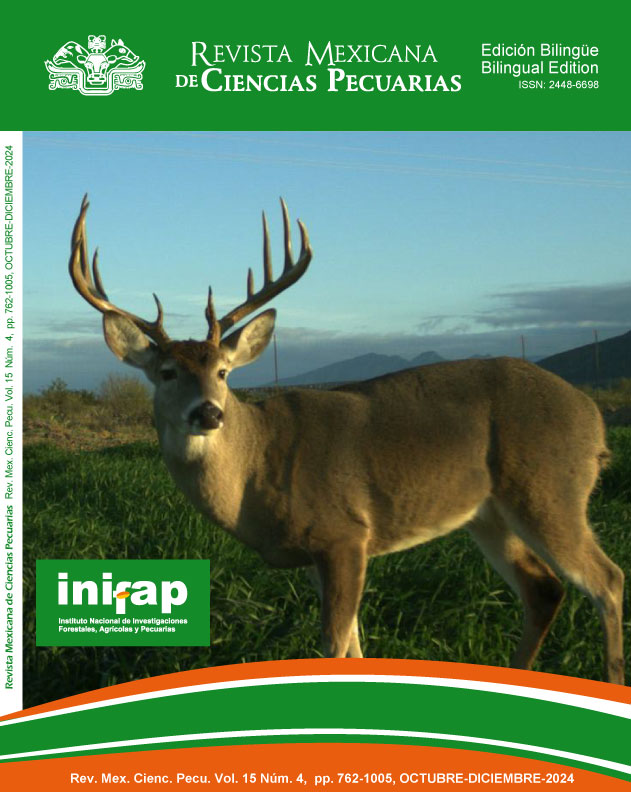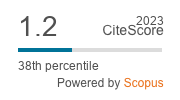Prevalence and diversity of zoonotic intestinal parasites in household dogs in urban areas of the Colombian Caribbean
DOI:
https://doi.org/10.22319/rmcp.v15i4.6647Palabras clave:
Intestinal parasites, Giardia, Blastocystis, Helminths, Zoonoses, ProtozoaResumen
Dogs offer multiple benefits in their relationship with humans, but they can also be carriers of zoonotic parasites that affect human and animal health. Zoonoses account for about 58% of all human infectious diseases. The objective of this study was to assess intestinal parasitism in dogs with owners in the City of Barranquilla in the years 2016 to 2018. A retrospective descriptive study was carried out that included 3,279 reports of parasitological evaluation of feces from a clinical laboratory that serves a network of veterinary services in the city of Barranquilla. 49.2 % of the dogs had some type of intestinal parasite. The most frequent were helminths: Strongyloides sp. 9.6 %, Toxocara canis 7.7 % and Ancylostoma caninum 6.2 %; and the protozoa: Entamoeba spp. 10.0 %, Isospora spp. 6.9 % and Giardia spp. 5.7 %. The Principal Component Analysis of the parasite profiles by year showed significant differences. The presence of zoonotically transmitted intestinal parasites in dogs evidenced the need to establish corrective and preventive measures in the field of public health that allow their control, since they constitute a significant risk of disease in the community.
Descargas
Citas
Jones BA, Grace D, Kock R, Alonso S, Rushton J, Said M. Zoonosis emergence linked to agricultural intensification and environmental change. PNAS USA. 2013;110(21):8399-8404. DOI: https://doi.org/10.1073/pnas.1208059110
Woolhouse MEJ, Gowtage-Sequeria S. Host range and emerging and reemerging pathogens. Emerg Infect Dis 2005;11(12):1842. DOI: https://doi.org/10.3201/eid1112.050997
Ritossa L, Viozzi G, Flores V. The state of knowledge on intestinal helminths in free-roaming dogs in southern South America. Canine Genet Health Med. 2021. https://www.intechopen.com/online-first/the-state-of-knowledge-on-intestinal-helminths-in-free-roaming-dogs-in-southern-south-america. Accessed Nov 22, 2023. DOI: https://doi.org/10.5772/intechopen.96125
Sotiriadou I, Pantchev N, Gassmann D, Karanis P. Molecular identification of Giardia and Cryptosporidium from dogs and cats. Parasite 2013;20(8):1-8. DOI: https://doi.org/10.1051/parasite/2013008
Dantas-Torres F, Otranto D. Dogs, cats, parasites, and humans in Brazil: Opening the black box. Parasite Vectors 2014;7(1):22. DOI: https://doi.org/10.1186/1756-3305-7-22
Inter-American Development Bank, Pan American Health Organization, Sabin Vaccine Institute. A Call to Action: Tackling soil-transmitted helminths in Latin America and the Caribbean 2011. http://www.paho.org/hq/in. Accessed Nov 30, 2023.
Ministry of Health and Social Protection, University of Antioquia. National Survey of Intestinal Parasitism in the School Population 2012 – 2014. Medellín: National Faculty of Public Health, University of Antioquia. 2015. https://www.minsalud.gov.co/sites/.../encuesta-nacional- of-parasitism-2012-2014.pdf. Accessed Nov 25, 2023.
DANE National Administrative Department of Statistics. National Quality of Life Survey 2023. https://www.dane.gov.co/index.php/sistema-estadistico-nacional-sen.
Ramírez-Cerpa E, Acosta-Coll M, Vélez-Zapata J. Analysis of weather conditions of short-term rainfall in urban areas: case study, Barranquilla, Colombia. Idesia 2017;35(2). https://www.cabdirect.org/cabdirect/abstract/20183232316. Accessed Nov 30, 2023.
Ministry of Health and Social Protection. Anti-rabies vaccination coverage by departments. 2016. https://www.minsalud.gov.co/sites/rid/Lists/Biblioteca Digital/RIDE/VS/PP/SA/Cobertura-vacunacion-antirrabica-departamentos-2016.pdf Accessed Nov 30, 2023.
DANE National Administrative Department of Statistics. Population projections of the National Administrative Department of. Statistics –DANE- 2005-2020. https://www.dane.gov.co/files/investigaciones/poblacion/.../8 Tablasvida1985_2020.pdf. Accessed May 30, 2023.
La Torre F, Di Cesare A, Simonato G, Cassini R, Traversa D, Frangipane di Regalbono A. Prevalence of zoonotic helminths in Italian house dogs. J Infect Dev Ctries 2018; 12(8):666-672. DOI: https://doi.org/10.3855/jidc.9865
Torres-Chablé OM, García-Herrera RA, Hernández-Hernández M, Peralta-Torres JA, Ojeda-Robertos NF, Blitvich BJ. Prevalence of gastrointestinal parasites in domestic dogs in Tabasco, southeastern Mexico. Rev Bras Parasitol 2015;24(4). DOI: https://doi.org/10.1590/S1984-29612015077
Soriano SV, Pierangeli NB, Roccia I, Bergagna HFJ, Lazzarini LE, Celescinco A, Basualdo JA. A Wide diversity of zoonotic intestinal parasites infects urban and rural dogs in Neuquén, Patagonia, Argentina. Vet Parasitology 2010;167(1):81-85. DOI: https://doi.org/10.1016/j.vetpar.2009.09.048
Sarmiento-Rubiano LA, Delgado L, Ruiz JP, Sarmiento MC, Becerra J. Intestinal parasites in dogs and cats from owners from the city of Barranquilla, Colombia. Rev Investig Vet Perú 2018;29(4). DOI: https://doi.org/10.15381/rivep.v29i4.15348
Dubey JP, Lindsay DS. Coccidiosis in dogs (Canis familiaris) In: Coccidiosis in livestock, poultry, companion animals, and humans, CRC Press: Boca Raton; 2020;245-254. DOI: https://doi.org/10.1201/9780429294105-20
Fantinatti M, Gonçalves-Pinto M, Lopes-Oliveira LA, Da-Cruz AM. Epidemiology of Giardia duodenalis assemblages in Brazil: there is still a long way to go. Memórias do Instituto Oswaldo Cruz. 2021;115:e200431. DOI: https://doi.org/10.1590/0074-02760200431
Buret AG, Cacciò SM, Favennec L, Svärd S. Update on Giardia: Highlights from the Seventh Int Giardia and Cryptosporidium Conf. Parasite 2020;27:49. DOI: https://doi.org/10.1051/parasite/2020047
Fusaro C, Chávez-Romero YA, Prada SL, Serrano-Silva N, Bernal JE, González-Jiménez FE, Sarria-Guzmán Y. Burden and epidemiology of human intestinal Giardia duodenalis infection in Colombia: a systematic review. Trop Med Infect Dis 2022;7(10): 325. DOI: https://doi.org/10.3390/tropicalmed7100325
Sarmiento-Rubiano LA, Filott M, Gómez L, Suarez-Marenco M, Sarmiento MC, Becerra JE. Comparative study of the intestinal parasitism profiles between communities across the five municipalities of the Barranquilla metropolitan area, Colombia. Osong Public Health Res Perspect 2021;12(5):333-341. DOI: https://doi.org/10.24171/j.phrp.2021.0181
Fu X, Zhong Y, Chen L, Ge M, Yu M, Sun Y, Shen L. Global burden and trends of the Entamoeba infection-associated diseases from 1990 to 2019: An observational trend study. Tropica Act 2023;240:106866. DOI: https://doi.org/10.1016/j.actatropica.2023.106866
Leung AK, Barankin B, Hon KL. Cutaneous larva migrans. Recent patents on inflammation and allergy drug discovery. 2017;11(1):2-11. DOI: https://doi.org/10.2174/1872213X11666170110162344
Streit A. Strongyloidiasis: Really a zoonosis? In: Strube C, Mehelhorn H, editors. Dog parasites Ahmed A, Ijaz M, Ayyub RM, Ghaffar A, Ghauri HN, Aziz MU, Javed MU. Balantidium coli in domestic animals: An emerging protozoan pathogen of zoonotic significance. Tropic Act 2020;203:105298. DOI: https://doi.org/10.1016/j.actatropica.2019.105298
Torrel TS, Vargas LA, Murga CA, Huaman V. Prevalence of Eimeria sp, and morphometric study of oocysts found in domestic dogs in Peru. Rev Vet 2022;33(1):59-62. DOI: https://doi.org/10.30972/vet.3315882
Gookin JL, Birkenheuer AJ, John S, Spector VM, Levy MG. Molecular characterization of trichomonads from feces of dogs with diarrhea. J Parasitol 2005;91(4):939–943. DOI: https://doi.org/10.1645/GE-474R.1
Pacheco-Ortega G A, Chan-Pérez JI, Ortega-Pacheco A, Guzmán-Marín E, Edwards M, Brown MA, Hernández-Cortazar IB. Screening of zoonotic parasites in playground sandboxes of public parks from subtropical Mexico. J Parasitology Res 2019;7409076. DOI: https://doi.org/10.1155/2019/7409076
Díaz-Anaya AM, Pulido-Medellín MO, Giraldo-Forero JC. Nematodes with zoonotic potential in public parks in the city of Tunja, Colombia. Public Health of Mexico. 2015;57(2):170-176. DOI: https://doi.org/10.21149/spm.v57i2.7413
Rostami A, Ma G, Wang T, Koehler AV, Hofmann A, Chang BC, Gasser RB. Human toxocariasis–a look at a neglected disease through an epidemiological ‘prism’. Infect Genet Evol 2019;74:104002. DOI: https://doi.org/10.1016/j.meegid.2019.104002
Descargas
Publicado
Cómo citar
-
Resumen343
-
PDF210
-
PDF 91
Número
Sección
Licencia

Esta obra está bajo una licencia internacional Creative Commons Atribución-NoComercial-CompartirIgual 4.0.
Los autores/as que publiquen en la Revista Mexicana de Ciencias Pecuarias aceptan las siguientes condiciones:
De acuerdo con la legislación de derechos de autor, la Revista Mexicana de Ciencias Pecuarias reconoce y respeta el derecho moral de los autores/as, así como la titularidad del derecho patrimonial, el cual será cedido a la revista para su difusión en acceso abierto.

Esta obra está bajo una Licencia Creative Commons Atribución-NoComercial-CompartirIgual 4.0 Internacional.





